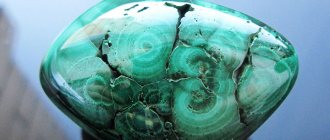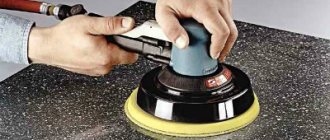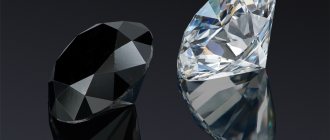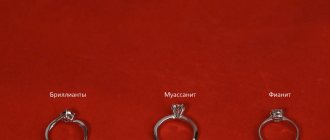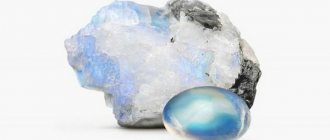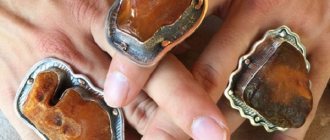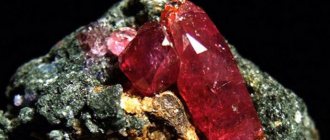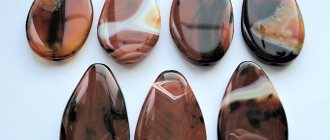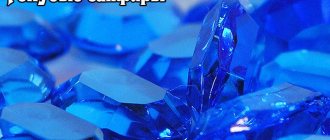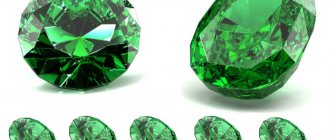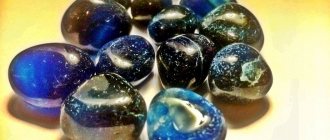In the photo: a ruby from Burma weighing 2.56 carats. Has not been refined
From this article you will learn about the features of various factors that you need to pay attention to when buying natural rubies. And the practical recommendations given will help you choose a sample of good quality that is pleasing to the eye.
Rubies are gemstones that are the red variety of the mineral corundum. They are “siblings” of sapphires in their chemical composition and structure. These are the most expensive colored stones. In terms of their value, the best specimens can compete with very expensive colored diamonds. So in May 2015, an unrefined Burmese red ruby weighing 25.59 carats was sold at Sotheby's for $30.3 million. This is a record for total value and a record for value per carat - $1,185,451/ct.
In this part, we will look at the three main factors that influence the cost of a stone: color, clarity and weight. In the second part, we will look at factors such as ruby cutting, its deposits, etc., which also affect pricing. We’ll also tell you about interesting varieties. In the third part we will show you the real prices for rubies per carat.
Ruby quality
Choosing a ruby is, first of all, an assessment of color. Rubies with an intense hue are most valued. Color evaluation also includes hue and saturation.
Natural ruby
The shade should be red. Depending on the origin, rubies with orange and purple hues are sometimes found. There are also secondary shades, but it is very important that they emphasize the color and not spoil it. The choice is up to the buyer; a lot depends on the person’s taste.
Tone describes a stone in terms of how dark or light it is. Contrary to popular belief, stones that have medium tones are most valued. Other minerals may not look very good, and this indicator impairs the perception of light saturation.
Saturation determines the intensity of the color. For corundums it should be maximum. Although in some cases, such flashy jewelry may not suit everyone. The main rule here is to take what you like.
Purity of ruby. Like any natural stone, ruby can have inclusions. These, along with cracks and defects, will also affect such characteristics of the stone as transparency. For a high quality ruby, it is important that there are fewer of them. The ideal option is to examine any inclusions only through a magnifying glass. The absence of any irregularities, defects, inclusions or color inhomogeneities indicates that the stone is a synthetic ruby.
Cut. This characteristic is significant. An uncut stone is inexpensive, does not have brilliance or beauty, since it does not have the ability to reflect and refract light. The higher the quality of the cut, the better these parameters are. Symmetry must be maintained and the edges must be polished.
The shape of the cut is also important. The most popular cut is round. It best demonstrates all the beauty of the stone, and there should be no shortened or elongated lower part. This is done in an attempt to make the stone larger visually or in weight in order to give it a higher value.
But in fact, such a technique can significantly reduce the beauty of the product. By the way, a properly cut stone will last longer. The cut shapes are also selected taking into account the fact that corundum can crack upon impact, and the cut will reduce the likelihood of such a nuisance.
Natural rubies, which are of low quality, are usually cut into cabochons. This cut was invented specifically to improve the depth of color of the mineral. Exceptions include rubies with star and cat's eye effects. Such stones always have a cabochon shape, since with other cuts the effect will not be noticeable, which is due to the refraction of light. These stones can be more expensive than regular stones, even of the highest quality. It is also worth mentioning the silk effect when white lines are evenly scattered throughout the thickness of the mineral.
Purity.
The fewer inclusions a ruby has and the less noticeable they are, the better the quality. It is best to choose rubies with defects that are invisible to the eye and only visible when magnified.
There are stones called “star rubies”, whose defects and inclusions decorate and give a special uniqueness to the stone.
Such rubies are polished like cabochons, which allows them to reflect the incident light in the form of a star with six rays. This is caused by the optical effect that the spider-web-like inclusions give.
Ruby processing
Typically, most mined rubies are of poor quality. And among those whose quality can be called decent, most are still not suitable for use in jewelry, and in fact this is a problem. Even with the increase in the volume of stone mining, high-quality gems are rare, which makes them expensive, but they are not enough to cover the need for the stone of everyone. Therefore, rubies that are slightly below the best in quality are treated to give them a more beautiful appearance. Such stones are cheaper.
Earrings with rubies
There are various processing methods, which can be divided into four types:
- Mechanical processing only. Includes cutting and polishing of the stone. This is a necessary action; even the highest quality rubies cannot do without such processing. It’s good if this is enough, but more often than not it’s not enough. After this treatment, the stone is a completely natural ruby.
- Heating the stones. Most minerals and all that have optical effects are processed this way. Heat is used to bring out the color of pale stones or to discolor those that are too dark. As a rule, during the heating process some inclusions melt, and their contents can fill cracks. All this happens in a special thermostat at high temperatures. The stone is coated with flux. As a side effect of heating, cracks on the surface are filled with molten flux. All this allows you to improve the quality of stones in the medium and good categories. Heat treatment leaves traces, so it can be excluded during any inspection by a geologist.
- Diffusion. This is if heating involves adding some additional substances to the flux. A special substance penetrates deep into the stone, coloring it. Unlike sapphires, which can be tinted with lithium or beryllium, which may not be noticeable, rubies are colored with chromium. The atomic mass of the latter is large, so it cannot penetrate deeply. The coloring is only superficial and can come off if the gem is damaged in any way. Such stones have a shallow color.
- Filling cracks. There are several substances that are used for this, but they must fulfill the basic requirements: to be durable, hard and transparent. This greatly improves the clarity of the stone, but some of these substances may gradually leak out, especially those that are also coloring.
Another treatment option is to fill the same cracks with conventional dyes. This is the most short-lived type. Such stones should be comparable in price to synthetic ones.
Origin testing.
Testing includes analysis of physical structure and chemical composition.
Even though synthetic and natural rubies are virtually identical, there are some very subtle differences that can be detected by the appropriate equipment.
Structural Differences: A gemologist can tell whether a ruby is synthetic by looking at its structure under a microscope.
Ruby has what are called "growth lines" - structural patterns that appear during its formation. Growth lines in synthetics are characteristically curved, indicating artificial origin.
Lab-created rubies may also have microscopic gas bubbles inside them that form during the manufacturing process.
Chemical Differences: The creation process leaves certain chemical traces in the stone that are not present in natural minerals. For example, even a small amount of lead may indicate artificial origin.
Although laboratory testing is the most accurate way to find out the origin of a ruby, it is not always reliable. The processes for creating the gemstone are constantly improving, and lab-created rubies are almost exactly identical to their natural counterparts.
How to distinguish a mineral from a fake?
How to distinguish a ruby? When assessing the brilliance of a stone's color, you should be wary of dark-colored gems. Often in this case the stone may not be a ruby at all, but a garnet. As a rule, garnets are also not the cheapest stones, at least some of their types are. However, they rarely reach the price of a natural ruby.
Natural and artificial rubies are among the hardest minerals. No stone can scratch them. Just don’t choose a diamond for testing; it has the greatest hardness and will scratch even a ruby. In addition, the ruby will easily leave a mark on the glass.
Most often they try to pass off rubies as:
- Garnets are dull minerals, much inferior in hardness to rubies.
- Tourmaline is similar to ruby, but is inferior in hardness and has a pinkish tint.
- Glass is easy to distinguish from ruby, it is softer, does not have such shine and play of colors.
- Composite rubies are stones that are made from rubies and glass. In order to protect yourself from buying such a fake, request a quality certificate.
Artificial rubies have appeared on the jewelry market for a long time. It is not inferior in characteristics to natural, but is cheap. All rubies purchased in the USSR were grown artificially. It was impossible to find natural stone in those days, except among the highest party officials.
There are several ways to grow ruby, some of which are constantly being improved. New technologies make it possible to achieve better color quality and uniformity. Contrary to the assurances of many sellers, only a professional can distinguish natural stone, and then, as a rule, by indirect signs. For example, many artificial rubies are free of defects.
Tips for choosing.
When purchasing a ruby, it is best to choose a stone that comes with a certificate proving its authenticity and origin. This is especially true if it is expensive and you need to be sure of the authenticity of the high quality of this stone.
Before purchasing, you should definitely inquire about possible processing in order to improve the properties of the ruby. Since this may then affect its inspection, cleaning and maintenance. In addition, you need to find out whether the ruby you are buying is artificial or natural.
Ruby is one of the most popular gemstones among jewelry lovers, but its popularity also means that there are many fakes that some sellers try to pass off as real rubies. Let's take a look at what fake rubies are made of and how you can identify these fakes.
A fake ruby is made from an artificial material such as glass or a non-ruby mineral.
It is important to distinguish between a fake ruby and a synthetic one.
While fakes have different chemical and physical properties compared to the real stone, synthetics have the same chemical composition and are technically a real ruby.
How to choose decoration?
When choosing jewelry with a ruby, you should also pay attention to such a thing as etiquette. There are certain rules for wearing jewelry, including those with these stones, without which you may appear ignorant or even vulgar. Rubies include the following tips:
- You should not choose a stone that is too massive for everyday decoration; in addition to the fact that wearing it during the day is unsightly, it is also inconvenient.
- Jewelry that is inexpensive in material and stones is suitable for girls. If they purchase a ruby, they should give preference to medium-sized gems.
- Married women are allowed to wear all types of stones, including natural ruby. The basic rule: the older the woman, the larger the stone.
- The same applies to the cost of jewelry; it should also directly depend on the woman’s age.
- Large stones in the ring are not suitable for women with thin fingers.
- Pendants should be worn with clothes that have a neckline, and long earrings should be worn with tied hair.
- Jewelry should be in harmony with each other and match your wardrobe; choose according to your taste in clothing.
- According to etiquette, rings should only be given to close people; they should not be purchased independently.
- It is believed that the color of the stone should also be combined with the color of the skin, so rubies are best preferred by women with warm tones.
The main thing you should pay attention to is that you like the stone. Even the most expensive gem should first and foremost bring pleasure to its owner. And the quality is always confirmed by a certificate from a recognized laboratory.
Physicochemical characteristics
Ruby is part of the corundum family . Chemical formula – Al2O3. The red color of the stone is formed due to the presence of ferrum, chromium and titanium in it. The color can vary from pink-red to purple with a red tint.
The physical properties look like this:
- jewelry class – 1;
- density – 3.97–4.05 g/cm3;
- light refraction – 1.766–1.774;
- hardness – 9 on the Mohs scale;
- transparent;
Interesting! The brilliance of corundum is comparable to that of diamond.
Cost of natural stones
How much a ruby costs is a pressing question for buyers. The price for 1 carat in rubles is tied to the quality of the stone and its size. In Russia, ruby prices are set by category:
- the first – 800–1500 dollars (50–95 thousand rubles) per 1 carat;
- second – 500–800 dollars (35–50 thousand rubles);
- third – 200–500 dollars (13–35 thousand rubles).
What is more expensive - a ruby or a diamond? Gems of ideal quality from Burmese deposits are sold at prices that exceed the cost of diamonds. At auctions, the purest ruby from Burma costs $1 million per carat .
Methods for synthesizing artificial crystals
In the mid-twentieth century, rubies grown synthetically began to appear on the jewelry market. Synthetic stones are visually almost no different from their analogues. Obtained by growing a single crystal from corundum.
Modern technologies make it possible to “grow” rubies with properties close to the original. Synthetic stones have ideal transparency, large size and almost complete absence of cracks. But an experienced jeweler can easily distinguish a stone of natural origin from a synthetic one.
Today, artificial rubies are produced using four methods:
- Czochralski;
- Vernel;
- flux;
- hydrothermal.
The most advanced methods are Czochralski and Vernel. By the way, the French scientist Vernel was the first who managed to grow synthetic ruby. Using these methods you can obtain the largest and cheapest stones. Minerals grown using these methods are distinguished by their curved growth lines.
Flux and hydrothermal methods are very expensive, but with their help it is possible to grow the most perfect rubies. Often, even experienced jewelers can hardly tell by eye what is a natural stone and what is synthetic. Therefore, when purchasing a large specimen, just in case, it is better to consult an experienced gemologist.
Medicinal properties
In ancient times, medicines were made from the gem by turning it into powder and infusing water on it. Belief in the healing properties of ruby has survived to this day. Application in lithotherapy :
- improving blood flow and toning blood vessels;
- stabilization of heart function;
- relieving depression;
- wound healing;
- stimulation of brain functions;
- treatment of paralysis and epilepsy.
Infused with solar energy, the crystal is applied to problem areas.
Advice for women: put the ruby in water and leave it overnight. Wash your face with this water in the morning: regular procedures will make your skin beautiful and youthful.
Who is suitable according to their zodiac sign?
There is no need to talk long about who the gem is suitable for in the zodiac circle: ruby will help everyone. Interaction with the elements of signs looks like this:
- Fire ( Sagittarius, Aries, Leo ) – energy replenishment, restoration of vitality and good spirits.
- Water ( Pisces, Cancer, Scorpio ) – gives composure to thoughts and actions, harmonizes character, softens manifestations of conceit.
- Air ( Aquarius, Gemini, Libra ) – eliminates uncertainty in decisions and actions. Teaches self-control and adds self-confidence.
- Earth ( Capricorn, Taurus, Virgo ) – strengthens the spirit, promotes the development of rational thinking.
Types of samples
To avoid buying a fake, it is important to know what rubies are found in nature. There are not so many of them, the main and most common are:
- Burmese ruby. Everything mined in Myama has a certificate. The price for them is always very high. The crystals are deep red in color and very bright.
- Pigeon blood. Stones mined in Myanmar must also have a certificate. They are distinguished by a very dark color, often giving off a purple tint. It is almost impossible to counterfeit “pigeon blood” due to some technical aspects of the process.
- Star crystals. They are the rarest and most expensive. The name speaks for itself. Inside the crystal, the glow has a star shape. And just like “pigeon blood”, it is impossible to fake starlight today.
Compatibility with other gems
In terms of image aesthetics, rubies can only be combined with diamonds and sea pearls . These minerals organically emphasize each other’s luxurious appearance.
In terms of energy, the gem matches well with fiery minerals, such as sapphire. It is categorically unacceptable to combine it with stones of the Water element. Contacting each other through energy channels, amethyst, amber and ruby destroy each other.
Ruby suppresses the minerals of the Earth, preventing them from revealing themselves energetically and magically. For Air stones (jade, agate) it can be neutral, but still tries to suppress them.
